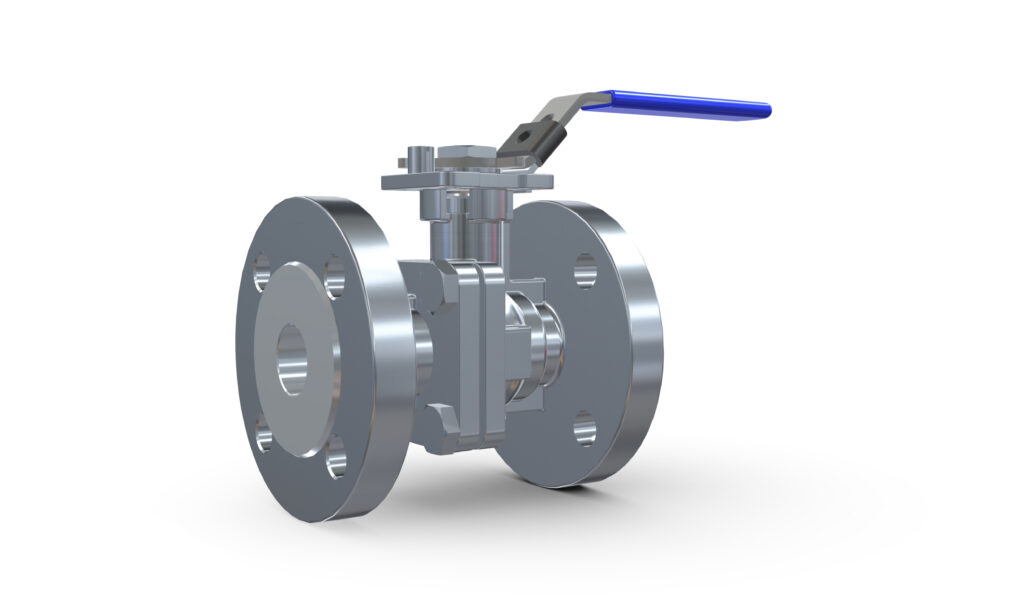A ball valve or ball valve is a type of valve that is widely used in various industries. It is a valve consisting of a spherical valve, often made of stainless steel, which is placed between two pipelines. By turning the sphere, the flow of liquids or gases is opened or closed.

Operation of ball valves
Ball valves are designed to quickly start or stop the flow of liquids or gases. When the bulb is in line with the pipeline, the medium flows freely through the valve. When the sphere is rotated 90 degrees, it is transverse to the pipeline and the flow is shut off. This makes the ball valve an ideal valve for applications where the medium must be shut off quickly.
The spherical seal of a ball valve is usually made of stainless steel, brass or bronze. The material of the sphere must be resistant to high pressures, temperatures and corrosion. The ball often has an opening that corresponds to the diameter of the pipeline, in order to restrict the flow as little as possible. The ball design also makes the valve less prone to clogging than other types of valves.
Advantages and disadvantages of ball valves
Ball valves can be opened and closed quickly, making them ideal for applications where the medium must be shut off quickly. This can help prevent accidents or damage. Ball valves generally require little maintenance. The ball design prevents clogging and the valve is often easy to disassemble for inspection and cleaning.
| Advantages | Disadvantages |
|---|---|
| Quick opening and closing | Possible leakage |
| High flow capacity | More expensive than gate valves |
| Long service life | Less suitable for high pressure applications |
| Low friction resistance | Possible clogging |
| Wide range of applications | Limited shut-off accuracy |
| Good corrosion resistance | |
| Easy to maintain |
Applications of ball valves
Ball valves are widely used in various industries, including chemical industry, petrochemical industry, oil and gas industry and food industry. Some examples of applications are:
- Gas and liquid lines. Ball valves are commonly used in gas and liquid lines to control flow and shut off the medium when required. The speed at which the valve can be opened and closed makes it ideal for applications where the media must be shut off quickly, such as in emergency situations or when changing equipment.
- Water treatment. Ball valves are widely used in water treatment plants to control the flow of water. They are also used to shut off the water during maintenance work.
- HVAC systems. Ball valves are widely used in heating, ventilation and air conditioning (HVAC) systems to control the flow of water or coolant. They are also used to seal the medium during maintenance work.
- Food industry. Ball valves are used in the food industry to control the flow of liquids, for example in the production of beverages or dairy products. Stainless steel ball valves are often used because of their corrosion resistance and hygienic properties.
- Oil and gas industry. Ball valves are widely used in the oil and gas industry to control the flow of gas or oil and to shut off the medium during maintenance work.
- Chemical and petrochemical industry. Ball valves are widely used in the chemical and petrochemical industries to control the flow of chemicals or other fluids and to shut off the medium during maintenance work.
Construction materials for ball valves
| Construction Material | Properties | Applications |
|---|---|---|
| Carbon Steel | Strong, durable, good heat and corrosion resistance | Water and steam systems, oil and gas industry, chemical industry |
| Stainless Steel | Corrosion-resistant, high strength | Food processing, pharmaceutical industry, marine applications |
| Alloy Steel | High strength, corrosion and heat resistance | Petrochemical industry, chemical industry, power plants |
| Bronze | Corrosion-resistant, good heat resistance, low friction | Water and gas pipelines, marine applications, wastewater treatment |
| Cast Iron | Inexpensive, strong and durable, good corrosion resistance | Water and gas pipelines, wastewater treatment, fire protection |
| Brass | Corrosion-resistant, low friction | Drinking water pipelines, low-pressure applications, HVAC systems |
| PVC | Corrosion-resistant, lightweight, inexpensive | Water and wastewater systems, swimming pools, irrigation systems |
International standards for ball valves
| Standard | Description | Countries |
|---|---|---|
| ISO 17292 | Metal ball valves for petroleum, petrochemical and allied industries | Worldwide |
| API 608 | Metal ball valves – Flanged and butt-welding ends | USA |
| ANSI/FCI 70-2 | Control valve seat leakage | USA |
| EN 1983 | Industrial valves – Marking of metallic valves | Europe |
| DIN 3357 | Ball valves | Germany |
| JIS B 2071 | Steel ball valves for general purposes | Japan |
| ASME B16.34 | Valves – Flanged, threaded and welding end | Worldwide |
| BS 5351 | Steel ball valves for the petroleum, petrochemical and allied industries | UK and many other countries |
| MSS SP-72 | Ball valves with flanged or butt-welding ends for general service | USA and many other countries |
| GB/T 12237 | Industrial valves – Steel ball valves | China |
| GOST 5556-81 | Steel ball valves for petroleum, petrochemical and allied industries | Russia and CIS countries |
Download free ball valve 3D CAD files

Heco.de is a well-known supplier of valves and fittings in the EU. Via their website you can download very good quality 3D CAD models without having to register.